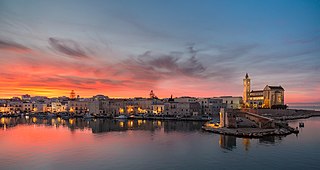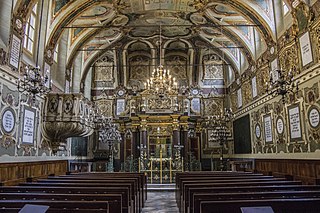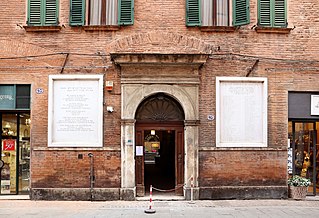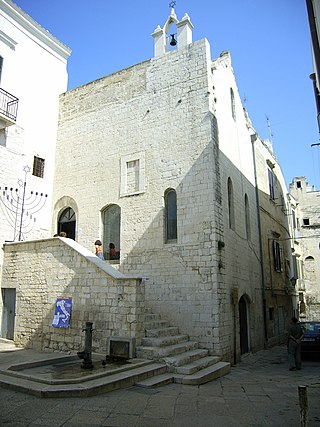
A synagogue, also called a shul or a temple, is a place of worship for Jews and Samaritans. It has a place for prayer where Jews attend religious services or special ceremonies such as weddings, bar and bat mitzvahs, choir performances, and children's plays. They also have rooms for study, social halls, administrative and charitable offices, classrooms for religious and Hebrew studies, and many places to sit and congregate. They often display commemorative, historic, or modern artwork alongside items of Jewish historical significance or history about the synagogue itself.

A Torah ark is an ornamental chamber in the synagogue that houses the Torah scrolls.

The Old New Synagogue, also called the Altneuschul, is an Orthodox Jewish congregation and synagogue, located in Josefov, Prague, in the Czech Republic. The synagogue is Europe's oldest active synagogue. Completed in 1270, it is also the oldest surviving medieval synagogue of twin-nave design.

Trani is a seaport of Apulia, Southern Italy, on the Adriatic Sea, 40 kilometres (25 mi) by railway west-northwest of Bari. It is one of the capital cities of the province of Barletta-Andria-Trani.

The Belgrade Synagogue, officially the Sukkat Shalom Synagogue, is an Orthodox Jewish congregation and synagogue, located in central Belgrade, near Obilićev Venac Square and central high street Knez Mihailova, in Serbia.

The Portuguese Synagogue, also known as the Esnoga, or Snoge, is a late 17th-century Sephardic synagogue in Amsterdam, completed in 1675. Esnoga is the word for synagogue in Judaeo-Spanish, the traditional Judaeo-Spanish language of Sephardi Jews.
The Jews of San Nicandro are a small community of proselytes from San Nicandro Garganico, Italy. The San Nicandro Jews are descended from local non-Jewish families from the 15th century. According to John A. Davis, professor of Italian history at the University of Connecticut, the Jews of San Nicandro represent "the only case of collective conversion to Judaism in Europe in modern times".

The Ben Ezra Synagogue, sometimes referred to as the El-Geniza Synagogue or the Synagogue of the Levantines (al-Shamiyin), is situated in the Fustat part of Old Cairo, Egypt. According to local folklore, it is located on the site where baby Moses was found.

The Central Synagogue of Aleppo,, also known as the Great Synagogue of Aleppo, Joab's Synagogue or Al-Bandara Synagogue, has been a Jewish place of worship since the 5th century C.E. in Aleppo. When it functioned, it was considered the main synagogue of the Syrian Jewish community. The synagogue is noted as being the location where the Aleppo codex was housed for over five hundred years until it was removed during the 1947 Aleppo pogrom, during which the synagogue was burned. The synagogue still stands but is in a ruined state.

The Synagogue of Casale Monferrato is a 16th-century synagogue located in Vicolo Salmone Olper in the traditionally Jewish quarter of Casale Monferrato, Province of Alessandria, region of Piedmont, Italy.

This article deals in more detail with some of the notable synagogues of Jerusalem that do not have their own page as yet.

The Włodawa Synagogue in Włodawa, Poland is an architectural complex consisting of two historic synagogues and a Jewish administrative building, now preserved as a museum. The complex includes the Włodawa Great Synagogue of 1764–74, the late 18th century Small Synagogue, and the 1928 community building. It is "one of the best-preserved" synagogues in Poland.

Córdoba Synagogue is a historic edifice in the Jewish Quarter of Córdoba, Spain, built in 1315. The synagogue's small size points to it having possibly been the private synagogue of a wealthy man. It is also possible that Córdoba's complex of buildings was a yeshivah, kollel, or study hall. Another possibility is that this was the synagogue of a trade guild, which converted a residence or one of the work rooms into the synagogue. The synagogue was decorated according to the best Mudejar tradition.

The Cherasco Synagogue is the old synagogue of the Jewish community of Cherasco, Italy.

St. Anne's Church is a Roman Catholic church located in the town of Trani, Apulia in Italy. Originally, it was built as the Scolagrande Synagogue by the Italian–Jewish community of Apulia during the Middle Ages; the structure houses now the Jewish Section of the Diocesan Museum of Trani.

The Italian Synagogue of Padua is the only synagogue still in use of the several that flourished in the university town of Padua from the Renaissance through World War II.

The Ferrara Synagogue is a synagogue located in Ferrara, Italy.

The history of the Jews in Apulia can be traced back over two thousand years. Apulia in Hebrew:פוליה) is a region in the "heel of the boot" of the peninsula of Italy bordering the Adriatic Sea. The Jews have had a presence in Apulia for at least 2000 years. The Jews of Apulia had a rich Rabbinic tradition and also had a sizeable Jewish population in the central Mediterranean prior to their expulsion.

The Jewish Museum of Rome is situated in the basement of the Great Synagogue of Rome and offers both information on the Jewish presence in Rome since the second century BCE and a large collection of works of art produced by the Jewish community. A visit to the museum includes a guided tour of the Great Synagogue and of the smaller Spanish Synagogue in the same complex.

The Etz Haim Synagogue is an Orthodox Jewish congregation and synagogue, located at Melidoni Street 8, in the Thiseio area of Athens, Greece. The synagogue was completed in 1904 by Greek Romaniote Jews who came from Ioannina, and for this reason it is also called the "Romanian" or "Yannonian" synagogue by the oldest members of the community. The synagogue is located across the street from the Beth Shalom Synagogue.




















